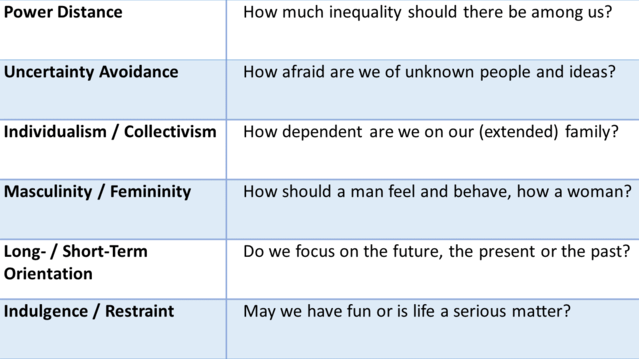Personality
Geert Hofstede: A Conversation About Culture
Beyond cultural dimensions
Posted February 21, 2017 Reviewed by Matt Huston
In 1970s, when Dutch social psychologist Geert Hofstede analyzed the surveys collected from over 100,000 IBM employees from 50 different countries, he found that people had distinct patterns of value systems that related to various aspects of their behavior. His analysis of what was at the time one of the largest existing cross-national databases yielded systematic differences across four dimensions: Power Distance, Uncertainty Avoidance, Individualism/Collectivism and Masculinity/Femininity. Later on, the analysis of a periodic World Values Survey inspired by Hofstede’s pioneering work added two more dimensions: Long-/Short-Term Orientation and Indulgence/Restraint.

Hofstede defined culture as “the collective programming of the mind that distinguishes the members of one group or category of people from others” (Hofstede, 2012) and his cultural dimensions became a paradigm for comparing cultures and understanding cross-cultural differences. The applications of Hofstede’s research on cultural dimensions, which have been externally validated and replicated numerous times, have extended across different fields including cross-cultural psychology, intercultural communication, international marketing, international management and negotiation.
Dr. Hofstede’s books have appeared in 21 languages and he is among the most widely cited social scientists in the world. Here are some of his most recent insights into culture’s role in our lives.
1. Is there a relationship between culture and personality? What is more predictive of human behavior: culture or personality?
You could compare culture and personality to a jigsaw puzzle and its pieces. A jigsaw puzzle is made of different pieces, just as all personalities within a culture are different. But all together they make up one particular puzzle and not another puzzle. If you want to know something about people (for example, their behavior), consider their personality. But if you want to know something about their society as a whole (for example, what is tolerated in the neighborhood), that has more to do with culture. Societies are made out of individuals and culture makes an imprint on the individuals who are born there. The first 10 years of our lives are very important. That’s when you get your basic mental programming and acquire characteristics that you could call culture.
2. What are some fundamental competencies necessary for cross-cultural understanding and cooperation?
Cross-cultural communication requires two parties. The first thing you need is a shared language. The other thing is an understanding of the shared rules of behavior, which means that you must understand the rules of the game. For example, in Japan, when people say yes it does not necessarily mean that they agree. But in the Netherlands, yes means that they agree. The competency you would need is the openness to learn these rules and not to be so much obsessed with your own ways that you are not prepared to accept that somebody else has their own way. To do that, you need self-awareness.

3. What advice would you have for people moving across cultures to best adapt to a new culture?
Curiosity is very important. Try to find out different things about the other culture. Learn about the other culture’s history, geography, literature and/or music.
4. Your research has been instrumental in exploring cultural influences on behavior in organizations. What are some practical applications of the cultural dimensions in the world?
It’s important to remember that cultural dimensions don't exist in real life. They are only a way of understanding a very complex world. They are a framework for making sense of differences. We can use them as long as they are practically meaningful. As such, the dimensions help us understand that what happens in one particular culture does not necessarily happen in another. For example, if a Dutch company wants to start operating in China, they cannot expect to educate their Chinese employees to behave like Dutchmen. That will not work. The only way they would succeed is if they understand the Chinese way of thinking and their rules. You have to recognize the differences and that there are different ways of thinking. It is not so difficult to understand other cultures, but it is very difficult to understand your own culture. Especially the way other people see you.
5. From your research, is there one dimension that has been the most controversial in defining cross-cultural differences?
One dimension that has been called controversial is the Masculinity/Femininity dimension. It could be partly due to a misunderstanding of the terms, which, in fact, come from the field of anthropology. Masculine and feminine are different from male and female. Males can be feminine and females can be masculine. Within all cultures there are behaviors and ways of thinking that are considered normal for boys or for girls. For example, in masculine societies it’s considered normal for boys to fight but not for girls. Or as another example, in masculine societies girls can cry, but boys shouldn't. On the other hand, in feminine societies, both boys and girls can cry and fight. In masculine societies there is a strict division of roles: men are supposed to be achieving and women are supposed to be caring. In feminine societies, men are also supposed to care and women are also supposed to achieve. Every cultural characteristic has its pluses and minuses. One of the weak sides of feminine societies is jealousy. In masculine societies when someone is very successful, they are admired. In feminine societies, when someone is achieving a lot, people get envious.
6. As societies become more intercultural, do you think cultures will retain their characteristic identities or move towards a more global mindset?
Fortunately, there are people all over the world nowadays who are continuing the branch of research that I started and collecting data on values. Thus, we can get samples from different countries every five years and see how they develop over time. When we compare how people answered my questions in the 1970s and how people answered the same questions in 2000, 30 years later, we see that there is no convergence. But on certain dimensions they shift together, like a train. For example, there is a worldwide decrease in Power Distance. The acceptance of inequality is decreasing, which can sometimes be a problem. There is also an increase in Individualism. However, again, all countries are shifting together: very individualistic societies are becoming even more individualistic and more collectivistic societies are becoming less collectivist. The same trend is observed for the Indulgence/Restraint dimension. Indulgent societies have become more indulgent and restrained societies have become less restrained. China is a good example of this. So, of course the young people in older societies are being influenced by the spirit of the age. However, cultures still retain their core identity, which is always relative to other countries. I think the values will persevere, but what they signify may change over time. As an example, consider the German saying Ordnung muss sein (There must be order). I don't think that will change over time, but what might change is what they will consider as Ordnung (order).
Many thanks to Dr. Geert Hofstede for being generous with his time and insights.
References
Hofstede, G. (2011). Dimensionalizing Cultures: The Hofstede Model in Context. Online Readings in Psychology and Culture, 2(1).
Hofstede, G., Hofstede, G. J. & Minkov, M. (2010). Cultures and Organizations: Software of the Mind (Rev. 3rd ed.). New York: McGraw-Hill.




